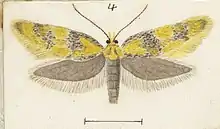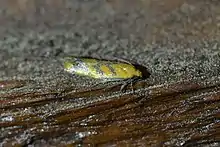| Tingena hoplodesma | |
|---|---|
 | |
| Male holotype | |
| Scientific classification | |
| Domain: | Eukaryota |
| Kingdom: | Animalia |
| Phylum: | Arthropoda |
| Class: | Insecta |
| Order: | Lepidoptera |
| Family: | Oecophoridae |
| Genus: | Tingena |
| Species: | T. hoplodesma |
| Binomial name | |
| Tingena hoplodesma | |
| Synonyms[2] | |
| |
Tingena hoplodesma is a species of moth in the family Oecophoridae.[2] It is endemic to New Zealand and has been found in the North and South Islands. T. hoplodesma prefers native beech forest habitat and adults are on the wing from January to March.
Taxonomy

This species was first described by Edward Meyrick in 1883 using specimens collected at South Rakaia in March by W. H. Gaze.[3] Meyrick originally named the species Oecophora hoplodesma.[3] Meyrick went on to give a fuller description of the species in 1884.[4] In 1915 Meyrick placed this species within the Borkhausenia genus.[5] In 1926 Alfred Philpott studied the genitalia of the male of this species.[6][2] In that publication Philpott also synonymised Borkhausenia thranias with Borkhausenia hoplodesma.[6] George Hudson discussed this species under the name Borkhausenia hoplodesma in his 1928 publication The butterflies and moths of New Zealand.[7] In 1988 J. S. Dugdale placed this species in the genus Tingena.[2] The male holotype specimen is held at the Natural History Museum, London.[2]
Description

Meyrick originally described this species as follows:
Fore wings narrow, pale yellow, anterior half of costa, three oblique fasciae and a hind marginal streak grey ; hind wings grey.[3]
Meyrick went on to describe the species in more detail as follows:
Male. — 12+1⁄2 mm. Head and palpi light yellow. Antennae dark fuscous. Thorax light yellow, mixed with fuscous grey. Abdomen whitish-grey. Legs dark grey, hairs of posterior tibiae and apex of all tarsal joints whitish. Forewings elongate, narrow, costa moderately arched, apex round-pointed, hindmargin extremely obliquely rounded ; light yellow, somewhat deeper in disc ; markings very pale whitish-grey, closely irrorated with dark grey scales ; a streak along anterior half of costa ; a cloudy spot on inner margin near base ; a narrow oblique transverse fascia from 1⁄4 of costa to before middle of inner margin, and a second from middle of costa to 3⁄4 of inner margin, both slightly interrupted below middle ; a third, less oblique, from 3⁄4 of costa to anal angle, obscurely connected with second near inner margin ; an irregular streak along hindmargin : cilia light yellow, with numerous lines of grey points. Hindwings grey ; cilia whitish-grey, base slightly darker.[4]
The grey bands of this species are variable, with some specimens having indistinct bands or them even being absent or sometimes replaced with grey speckling.[7]
Distribution

This species is endemic to New Zealand and has occurred in Whangārei, Kapiti Island, Nelson, Rakaia, Prices Valley, Canterbury, Dunedin and Lake Wakatipu.[1][8][9]
Behaviour
The adults of this species are on the wing between January and March.[7]
Habitat
References
- 1 2 Gordon, Dennis P., ed. (2010). New Zealand inventory of biodiversity: Kingdom animalia: chaetognatha, ecdysozoa, ichnofossils. Vol. 2. p. 462. ISBN 978-1-877257-93-3. OCLC 973607714. OL 25288394M. Wikidata Q45922947.
- 1 2 3 4 5 John Stewart Dugdale (23 September 1988). "Lepidoptera - annotated catalogue, and keys to family-group taxa". Fauna of New Zealand. Department of Scientific and Industrial Research. 14: 102. doi:10.7931/J2/FNZ.14. ISSN 0111-5383. Wikidata Q45083134.
- 1 2 3 Edward Meyrick (September 1883). "Descriptions of New Zealand Micro-Lepidoptera.—III.—Oecophoridae". New Zealand Journal of Science. 1: 525. Wikidata Q106368126.
- 1 2 Edward Meyrick (1884). "Descriptions of New Zealand Microlepidoptera. III. Oecophoridae". Transactions and Proceedings of the New Zealand Institute. 16: 44. ISSN 1176-6158. Wikidata Q63976486.
- ↑ E. Meyrick (12 July 1915). "Revision of New Zealand Tineina". Transactions and Proceedings of the New Zealand Institute. 47: 212. ISSN 1176-6158. Wikidata Q63123349.
- 1 2 Alfred Philpott (1926). "List of New Zealand species of Borkhausenia (Oecophoridae: Lepidoptera), including new species". Transactions and Proceedings of the New Zealand Institute. 56: 399–413. ISSN 1176-6158. Wikidata Q110157185.
- 1 2 3 4 George Vernon Hudson (1928), The butterflies and moths of New Zealand, Illustrator: George Hudson, Wellington: Ferguson and Osborn Limited, pp. 261–262, LCCN 88133764, OCLC 25449322, Wikidata Q58593286
- ↑ "Tingena hoplodesma". aucklandmuseum.com. 2021. Retrieved 29 December 2021.
- ↑ "Prices Valley, Little River. Christchurch District Plan Site of Ecological Significance" (PDF). districtplan.ccc.govt.nz. Retrieved 29 December 2021.